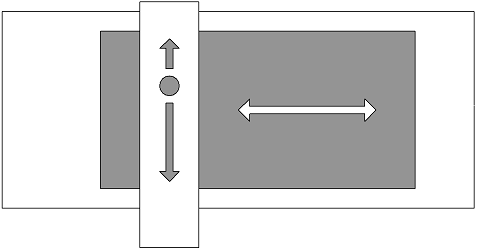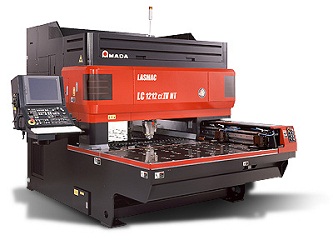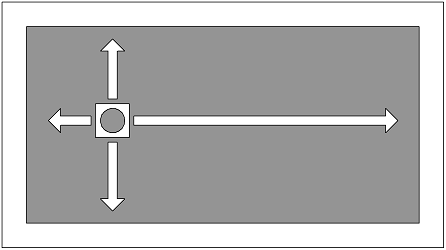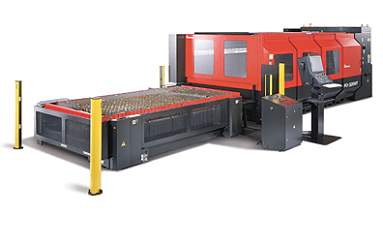Laser cutting technology directs the output of a high powered laser at a very small point on the material intended to be cut. The sheet metal at the point of focus becomes molten and is blown away by a focused jet of gas. Without the aid of a focused jet of gas most metal will absorb the heat and a much larger molten area would form. The assist gas is typically regular shop air, oxygen, nitrogen or argon. The different gases will address the coloration of the cutting edge. Oxygen and shop air is used when discoloration from oxidation is not an issue. Nitrogen and argon are used to prevent the oxidation to discolor the edge; this is especially common in the cutting of stainless steel. Properly adjusted laser cutting leaves a very clean edge without the need for secondary operations such as burr removal. The kerf of a laser is very small, typically only a few thousandths of an inch. This allows for a great amount of flexibility of profiles when cutting with lasers. The narrow kerf allows for very efficient nesting of parts, which means higher sheet utilization. Because there is no contact between the cutting system and the sheet metal, there is no deformation around the cutting edge. This allows for very fine and intricate profiles to be cut. The consumables on laser cutting systems are rather minimal. Lenses and nozzles will wear out every few months and need to be replaced, however this is significantly less than the consumables on water jet or Punch Press systems.
Lasers used for cutting sheet metal typically vary between 1000 and 5000 Watts though there can be some variation. Most laser cutting systems use an array of mirrors to direct the beam at the sheet metal; however the use of fiber optics is now becoming a viable option. The use of fiber optics eliminates the challenges associated with aligning and maintaining the mirrors.
Types of Lasers
Gas Type
The type of gas used in the resonator will determine the type of power output that the laser is capable. CO2 lasers are used in the cutting of a variety of sheet metals including, but not limited to, mild steel, aluminum, stainless steel ant titanium. Because the resonators are relatively inexpensive CO2 lasers are the most common type used for cutting sheet metal. Neodymium lasers are typically used for very high energy applications, however because their relatively low frequencies they are used for cutting thicker metals or boring type operations. Neodymium Yttrium-Aluminum-Garnet type lasers are very similar to Neodymium lasers and produce very high energy pulses. These types are used for boring or engraving very tough materials such as ceramics.
Power Output
The wattage output of the laser will determine what thickness, how fast and what materials the cutting system can handle. At the low end of the manufacturing spectrum is a 1000 Watt system. This system will be able to cut lighter gauges at low speeds. 2 and 3 Kilowatt systems will be able to cut steel up to about 1/2 an inch and will be adequate for most small workshops. High powered systems up to 6 Kilowatts will be able to cut very thick materials even at high speeds.
Power Transmission
How the power is brought from the resonator to the focusing lens will have a significant impact on the maintenance of the system. Older laser cutting systems will use a system of mirrors to direct the beam to the sheet metal. These systems are prone to require more maintenance to keep the mirrors in alignment. When mirrors need to be replaced the realignment process can take a few hours. More modern systems are incorporating a flexible fiber optic thread to transmit the laser beam. The fiber optic systems do not require the same kind of alignment as the mirrored systems.
Sheet Control
There are two basic forms of sheet control used in the cutting of sheet metal. The most basic form moves the sheet forwards and backwards while the laser head is moved left to right. This type of sheet control is found on less expensive machines and requires some consideration when cutting the sheet metal. Because the sheet is moved back and forth pieces that are being cut from the sheet need to be held in place using tabs. If they are not held securely the movement of the sheet can dislocate the parts or cause a bad cut. Below is a vertical view of how the sheet and laser head is moved, as well as an example of the Amada Pulsar, a laser cutting system which incorporates this method.


The other major form for sheet control utilizes a fixed sheet while the laser optic is moved over the sheet. This method is commonly referred to a flying optic system. While additional transmission mirrors are required the lack of tabbing allows for cleaner parts and quicker cutting. The majority of these systems come with loading and unloading automation as shown in the example to the right of the Amada FO4020.


Automation
The use of automation in sheet metal fabrication can be a tremendous time saving element. One of the most significant time saving elements that automation addresses is the loading and unloading of new sheets. The latest generation of process controlling software guarantees consistent and reliable cutting by precisely inspecting the metal’s thickness before loading and aligning it perfectly on the cutting bed. Sensors in the cutting head ensure that the gap between the focusing lens and the sheet metal is precisely maintained. Consistency in this spacing is crucial to creating a clean cut.
Software
Modern process control software is able to interpret and unfold 3d models, then efficiently nest parts from different jobs onto the same sheet in order to maximize yield. Scheduling, job tracking, part sorting, and pricing is often built into the same software allowing for the highly controlled and precise blanking of parts. These packages are also able to tie together the different automation systems allowing for continuous cutting and unloading of parts without any operator interaction. This allows for what is known as ‘lights out’ manufacturing.
Video
Below is a video from LVD Strippet, one of the worlds sheet metal processing companies, demonstrating the features of a modern 5000 Watt laser cutting system.